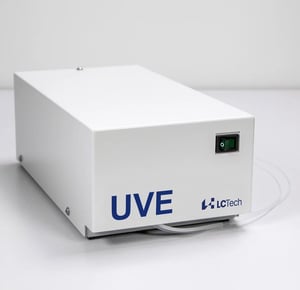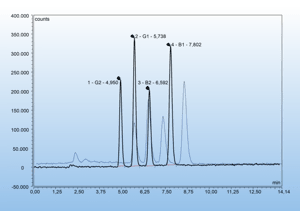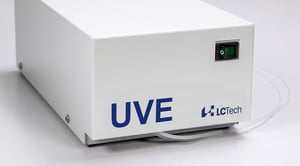UVE

PHOTOCHEMICAL DERIVATISATION
UVE Derivatisation of Aflatoxins with UV Light
The UVE photochemical reactor enables aflatoxins to be analysed with HPLC fluorescence in the simplest way.
NEW:
Improved reactor-coil available as an upgrade , for faster and more cost-effective mycotoxin analysis!
- Home
- Products
- Mycotoxin Products
- UVE Photochemical Derivatisation
UPGRADE AVAILABLE NOW
Improved
Reactor coil for UVE
The new reactor coil for the UVE photochemical reactor ensures significantly shorter chromatographies, a 10 % increase in sample throughput, increased sensitivity and constant efficiency.
Further highlights:
- Reduced peak width (almost 40 %)
- Optimised LOD/LOQ, while maintaining the same chromatography parameters
- Linear performance over the entire spectrum of analyte concentration
- Compatible with HPLC sampler injection and our fully automated sample preparation devices
Photochemical derivatisation with new improved reactor coil (black) compared to previous photochemical derivatisation with UVE (blue).

UVE ADVANTAGES AT A GLANCE
Photochemical, Simple and without Chemicals
The low inherent fluorescence of aflatoxins B1 and G1 makes derivatisation necessary for fluorescence analysis in order to comply with analytical limit values. This can be carried out easily, conveniently and inexpensively with the UVE using photochemical radiation with UV light at 254 nm, which leads to stable, measurable fluorescence. No additional reagents need to be added.
An AOAC-recognised procedure (Waltking et al. 2006), which is an inexpensive, simple, yet stable, method of analysing aflatoxins in the ppt range, particularly for the most strictly regulated aflatoxins.
- No halogenated waste
- No special derivatisation controls necessary
- Fewer expensive chemicals
- Simple, robust use
- Long service life
UVE Highlights
-No halogenated waste
- No special derivatisation controls
necessary
- Fewer expensive chemicals
Wide range of uses
Can be used for the analysis of vitamin B3 (niacin) and cosmetics (NDELA)
The UVE can also be used in the analysis of niacin (vitamin B3) and for cosmetic products for the detection of the carcinogenic compound N-nitrosodiethanolamine (NDELA) according to ISO/DIS 10130 (method K84.00-7 (EC)).
Specification
Reactor loop
1 mL
Power supply
220-265 VAC, 50/60 Hz (order no. 10519)
90-126 VAC 50/60 Hz (order no. 10742)
Power consumption
100 W
Dimensions (wxhxd)
145 x 100 x 275 mm
Weight
3 kg
